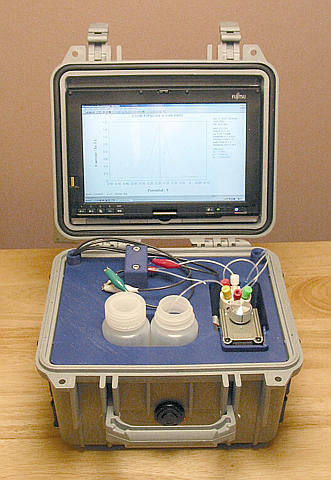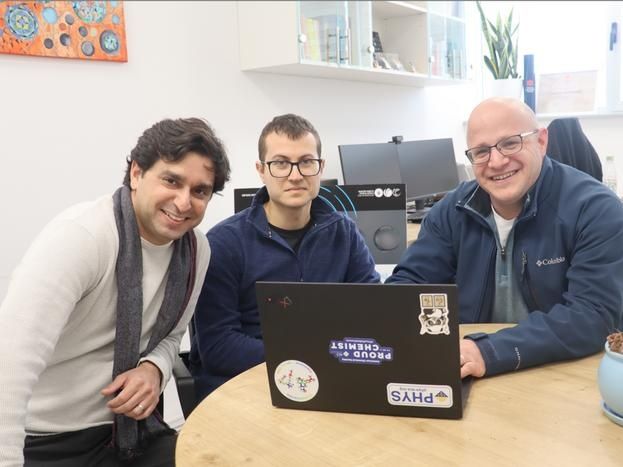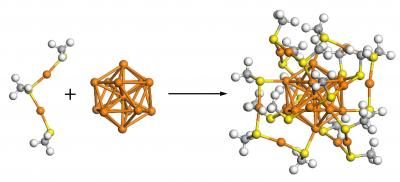New sensor system improves detection of lead, heavy metals
PNNL develops inexpensive portable detection system for rapid, accurate analysis of toxic metals
The Department of Energy's Pacific Northwest National Laboratory has developed a new rapid, portable and inexpensive detection system that identifies personal exposures to toxic lead and other dangerous heavy metals. The device can provide an accurate blood sample measurement from a simple finger prick, which is particularly important when sampling children.

Pacific Northwest National Laboratory
PNNL's portable analyzer system accurately detects lead and other toxic metals in blood as well as in urine and saliva. Results are as reliable as those of current state-of-the-art mass spectrometry systems many times its size. This new system provides a quicker, simpler and easier method of monitoring toxic metal exposures in high-risk populations, such as industrial workers, children and people living in polluted areas.
A bit larger than a lunchbox, the new detection system is field-deployable with plug-and-play features that allow different sensors to be easily exchanged to detect a variety of heavy metal toxins. The entire system is battery-operated and requires about one and one-half times the power of a typical laptop computer. The system also routinely delivers reliable measurements within a rapid two-to-five minute analysis period.
Early production cost estimates indicate that the device may be as much as 10 times less expensive than existing plasma mass spectrometry systems, which lack field portability and require samples to be returned to the lab for time-consuming and more expensive analysis.
"We need next-generation analyzers to reduce the time and lower the costs of analysis for clinical diagnosis," said PNNL scientist and principal investigator Wassana Yantasee. "They will help us better understand the relationship between the exposure to these toxins and how the body responds, which will help in developing new strategies to reduce exposures and risks."
"Our research has focused on optimizing the sensor systems to work with the biological complexities in blood, urine and saliva samples," said Yantasee. "Validation of these sensor platforms for use in biomonitoring is particularly important in developing a personalized exposure assessment strategy."
The device can use two classes of sensors for detecting lead and other heavy metals. The first is based on a flow injection system using a mercury-film electrode to analyze metals in blood, urine or saliva samples.
To eliminate the use of toxic mercury in conducting the analysis, the second class of the sensor uses a mercury-free approach of nanostructure materials developed at PNNL. This involves use of either Self-Assembled Monolayers on Mesoporous Supports - SAMMS(TM) technology - or functionalized magnetic nanoparticles that provide excellent detection sensitivity at a parts-per-billion level.
Battelle, which operates PNNL for DOE, filed a patent application in December 2007 for the improved sensor technology used in this next-generation biomonitoring device. Battelle is seeking commercialization partners and welcomes companies interested in the technology to contact Commercialization Manager Bruce Harrer or access Portable Electrochemical Sensing System for more information.
Topics
Organizations
Other news from the department science
These products might interest you

SprayMaster inspex by LaVision
Quality Control for Your Spraying Process Through Digital Spray and Particle Analysis
Reliable, Automated, Digital - The Geometry Measurement of Your Spraying Process in Real Time

FireSting-PRO by PyroScience
New fiber optic measuring device: Precise measurements even in the smallest volumes
Measure pH, oxygen and temperature even under sterile conditions

VEGAPULS | VEGABAR | VEGASWING by VEGA Grieshaber
Cyber-safe level measurement - here's how it works
Find out more about the unique sensor for liquid and solid media

Get the chemical industry in your inbox
By submitting this form you agree that LUMITOS AG will send you the newsletter(s) selected above by email. Your data will not be passed on to third parties. Your data will be stored and processed in accordance with our data protection regulations. LUMITOS may contact you by email for the purpose of advertising or market and opinion surveys. You can revoke your consent at any time without giving reasons to LUMITOS AG, Ernst-Augustin-Str. 2, 12489 Berlin, Germany or by e-mail at revoke@lumitos.com with effect for the future. In addition, each email contains a link to unsubscribe from the corresponding newsletter.
Most read news
More news from our other portals
See the theme worlds for related content
Topic World Mass Spectrometry
Mass spectrometry enables us to detect and identify molecules and reveal their structure. Whether in chemistry, biochemistry or forensics - mass spectrometry opens up unexpected insights into the composition of our world. Immerse yourself in the fascinating world of mass spectrometry!

Topic World Mass Spectrometry
Mass spectrometry enables us to detect and identify molecules and reveal their structure. Whether in chemistry, biochemistry or forensics - mass spectrometry opens up unexpected insights into the composition of our world. Immerse yourself in the fascinating world of mass spectrometry!
Topic world Sensor technology
Sensor technology has revolutionized the chemical industry by providing accurate, timely and reliable data across a wide range of processes. From monitoring critical parameters in production lines to early detection of potential malfunctions or hazards, sensors are the silent sentinels that ensure quality, efficiency and safety.

Topic world Sensor technology
Sensor technology has revolutionized the chemical industry by providing accurate, timely and reliable data across a wide range of processes. From monitoring critical parameters in production lines to early detection of potential malfunctions or hazards, sensors are the silent sentinels that ensure quality, efficiency and safety.
Last viewed contents
2-Butoxyethanol
Monte_Carlo_Universal
Intricate, curving 3D nanostructures for biological and materials applications
Measurement method for determining concentrations in dust deposition
Lipoxygenase
Atmospheric Measuring Device for Understanding Smog Formation - Quantitative assessment could lead to more effective smog-control strategies





























































